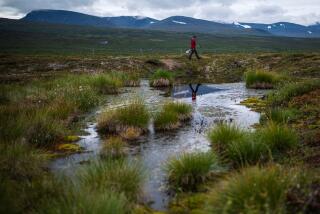Scientists Warn of Losses in Ozone Layer Over Arctic
- Share via
The thinning ozone layer over the Arctic may be headed for even more dramatic losses because of global warming, according to research that will be presented Wednesday at the American Geophysical Union meeting in Washington, D.C.
Currently, ozone depletion is much more severe over the Antarctic, where there is a hole in the ozone layer. But the phenomenon is more troublesome over the Northern Hemisphere, where it could expose large numbers of people and animals to more ultraviolet radiation, which can cause skin cancer and disrupt reproduction of some animals.
The new study, which was published in Friday’s issue of the journal Science, examined the role of the polar clouds that form in the stratosphere, nine to 25 miles above the planet’s surface. Such clouds provide a surface where harmless forms of chlorine can turn into their ozone-destroying cousins. The troublesome clouds are persistent features of the Antarctic stratosphere, where temperatures are colder than in the Arctic.
The Arctic could soon become “Antarctic like”--colder and filled with polar clouds for longer periods, said Azadeh Tabazadeh, an atmospheric chemist at the NASA Ames Research Center in Mountain View, Calif., who led the ozone study.
“We do know [that] if the temperatures in the stratosphere are lower, more clouds will form and persist, and these conditions will lead to more ozone loss,” said Michelle Santee, an atmospheric scientist at NASA’s Jet Propulsion Laboratory in Pasadena and co-author of the study.
The large polar clouds provide a “double whammy,” scientists said. The clouds are formed from condensed nitric acid and water. When they become large, nitrogen that normally acts to stop ozone loss falls out of the clouds as snow.
“If you’ve removed the nitrogen, you’ve removed the switch that turns ozone destruction off at the end of the winter,” Santee said. Ozone loss in spring is most detrimental, because it increases with energy from sunlight.
The stratospheric cooling may be related to global warming. Although greenhouse gases cause the Earth’s temperature to rise at the surface, they lead to cooling in the upper atmosphere, which contributes to ozone destruction.
The use of chlorofluorocarbons, or CFCs, the human-made chemicals that contribute to ozone depletion, has been restricted since 1996. Although the chemicals are decreasing in the upper atmosphere, the ozone layer has not yet recovered. It has been expected to do so by 2050.
However, the current study, said Tabazadeh, shows that ozone recovery “will take longer than originally thought.”






